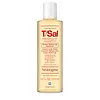What's inside
What's inside
 Key Ingredients
Key Ingredients

 Benefits
Benefits

 Concerns
Concerns

 Ingredients Side-by-side
Ingredients Side-by-side

Water
Skin ConditioningCoco-Betaine
CleansingTea-Cocoyl Glutamate
CleansingDisodium Laureth Sulfosuccinate
CleansingSodium Lauroyl Methylaminopropionate
CleansingSodium Lauroyl Methyl Isethionate
CleansingPolyquaternium-10
Caprylyl Glycol
EmollientMenthol
MaskingPPG-3 Myristyl Ether
EmollientRehmannia Chinensis Root Extract
Skin ConditioningCitrus Nobilis Peel Extract
MaskingPentasodium Pentetate
Salicylic Acid
MaskingPanthenol
Skin ConditioningMentha Arvensis Leaf Oil
MaskingCitrus Aurantifolia Oil
CleansingButylene Glycol
HumectantMentha Arvensis Extract
MaskingNiacinamide
Smoothing1,2-Hexanediol
Skin ConditioningChrysanthemum Zawadskii Extract
Skin ConditioningGlycyrrhiza Glabra Root Extract
BleachingLycium Chinense Fruit Extract
AntioxidantBiota Orientalis Leaf Extract
HumectantAcorus Calamus Root Extract
PerfumingMorus Alba Bark Extract
Skin ConditioningXanthium Strumarium Fruit Extract
Skin ConditioningPanax Ginseng Root Extract
EmollientAcacia Senegal Gum
MaskingPeat Water
Skin ConditioningGlycerin
HumectantCitric Acid
BufferingHydroxypropyl Methylcellulose
Emulsion StabilisingEthylhexylglycerin
Skin ConditioningCentella Asiatica Leaf Extract
Skin ConditioningGlycine Soja Seed Extract
Skin ConditioningVaccinium Angustifolium Fruit Extract
Skin ProtectingRubus Fruticosus Fruit Extract
AstringentRibes Nigrum Fruit Extract
AstringentNigella Sativa Seed Extract
PerfumingOryza Sativa Extract
AbsorbentSesamum Indicum Seed Extract
Skin ConditioningSalvia Hispanica Seed Extract
EmollientPotassium Sorbate
PreservativeHydrogenated Lecithin
EmulsifyingCeramide NP
Skin ConditioningPropolis Extract
Skin ConditioningWater, Coco-Betaine, Tea-Cocoyl Glutamate, Disodium Laureth Sulfosuccinate, Sodium Lauroyl Methylaminopropionate, Sodium Lauroyl Methyl Isethionate, Polyquaternium-10, Caprylyl Glycol, Menthol, PPG-3 Myristyl Ether, Rehmannia Chinensis Root Extract, Citrus Nobilis Peel Extract, Pentasodium Pentetate, Salicylic Acid, Panthenol, Mentha Arvensis Leaf Oil, Citrus Aurantifolia Oil, Butylene Glycol, Mentha Arvensis Extract, Niacinamide, 1,2-Hexanediol, Chrysanthemum Zawadskii Extract, Glycyrrhiza Glabra Root Extract, Lycium Chinense Fruit Extract, Biota Orientalis Leaf Extract, Acorus Calamus Root Extract, Morus Alba Bark Extract, Xanthium Strumarium Fruit Extract, Panax Ginseng Root Extract, Acacia Senegal Gum, Peat Water, Glycerin, Citric Acid, Hydroxypropyl Methylcellulose, Ethylhexylglycerin, Centella Asiatica Leaf Extract, Glycine Soja Seed Extract, Vaccinium Angustifolium Fruit Extract, Rubus Fruticosus Fruit Extract, Ribes Nigrum Fruit Extract, Nigella Sativa Seed Extract, Oryza Sativa Extract, Sesamum Indicum Seed Extract, Salvia Hispanica Seed Extract, Potassium Sorbate, Hydrogenated Lecithin, Ceramide NP, Propolis Extract
 Reviews
Reviews

Ingredients Explained
These ingredients are found in both products.
Ingredients higher up in an ingredient list are typically present in a larger amount.
Citric Acid is an alpha hydroxy acid (AHA) naturally found in citrus fruits like oranges, lemons, and limes.
Like other AHAs, citric acid can exfoliate skin by breaking down the bonds that hold dead skin cells together. This helps reveal smoother and brighter skin underneath.
However, this exfoliating effect only happens at high concentrations (20%) which can be hard to find in cosmetic products.
Due to this, citric acid is usually included in small amounts as a pH adjuster. This helps keep products slightly more acidic and compatible with skin's natural pH.
In skincare formulas, citric acid can:
While it can provide some skin benefits, research shows lactic acid and glycolic acid are generally more effective and less irritating exfoliants.
Most citric acid used in skincare today is made by fermenting sugars (usually from molasses). This synthetic version is identical to the natural citrus form but easier to stabilize and use in formulations.
Read more about some other popular AHA's here:
Learn more about Citric AcidSalicylic Acid (also known as beta hydroxy acid or BHA) is a well-known ingredient for treating skin that struggles with acne and clogged pores. It exfoliates both the skin's surface and deep within the pores to help clear out buildup, control oil, and reduce inflammation.
Unlike AHAs (alpha hydroxy acids), salicylic acid is oil-soluble. This allows it to penetrate into pores which makes it especially effective for treating blackheads and preventing future breakouts.
Salicylic acid is also known for its soothing properties. It has a similar structure to aspirin and can calm inflamed or irritated skin, making it a good option for acne-prone skin that is also sensitive.
Concentrations of 0.5-2% are recognized by the U.S. FDA as an over-the-counter topical acne product.
It can cause irritation and/or dryness if one's skin already has a compromised moisture barrier, so it's best to focus on repairing that before introducing this ingredient into your routine.
While salicylic acid does not increase sun sensitivity, it’s still important to wear sunscreen daily to protect your skin.
If you are looking for the ingredient called BHA or Butylated Hydroxyanisole, click here.
Learn more about Salicylic AcidWater. It's the most common cosmetic ingredient of all. You'll usually see it at the top of ingredient lists, meaning that it makes up the largest part of the product.
So why is it so popular? Water most often acts as a solvent - this means that it helps dissolve other ingredients into the formulation.
You'll also recognize water as that liquid we all need to stay alive. If you see this, drink a glass of water. Stay hydrated!
Learn more about Water